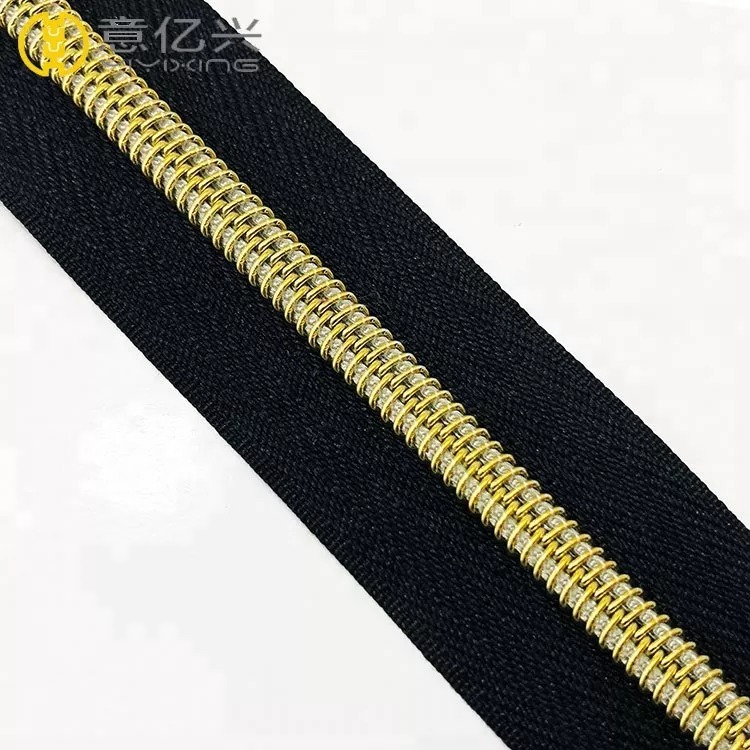There are 3 main categories of zippers, which are based on 3 different types of materials:
1. Metal zipper
Metal zipper Metal zipper is the most basic original zipper produced first. The first zippers were made of metal around the 1917s and 1920s. As the slider slides up in the zipper, these elements tightly interlock to keep the zipper closed.
Metal zippers are divided into 2 groups according to the materials used and the manufacturing process:
Teeth are made of wire, whether flat or profiled, of brass, aluminium, nickel or white brass (nickel free)
Teeth die cast directly on tape with zinc metal
Metal zippers are usually made in a variety of finishes, such as gold brass, antique brass, antique silver, bronze, silver, and more. These finishes are achieved through chemical treatment of the zipper chain and matching plating of the sliders and end stops.
Generally speaking, metal zippers are available in a variety of finishes, but the most commonly used zipper finishes are as follows:
Aluminium: Elements are made of aluminium
Brass: The element is made of a brass alloy, usually a combination of copper and zinc
Antique Brass: Elements made of brass that have been chemically treated to give a worn brass look
Black Oxide: Elements are made of brass, chemically treated to give a black matte finish

2. Molded plastic zipper
Zipper Molded Plastic These plastic zippers have individually injection molded teeth that are fused directly to the zipper's straps. The high-performance resins used to make moulded plastic elements are very strong and make zippers that are durable, strong and flexible. These zippers are perfect for outerwear and heavyweight clothing or any outdoor application.
Plastic zippers are divided into 5 groups:
LFC or L-shaped zipper, made of zigzag/Ruhrmann-shaped loops sewn around the edge of the carrier tape.
The CFC zipper is made of helical coils, sewn to one side of the carrier tape.
Braided coil zipper in which the coils are formed on a special loom and woven directly into the carrier tape.
Plastic molded zippers in which teeth/elements made of polyacetal (often called Delrin) are molded directly onto the carrier tape.
The plastic extrusion zipper first extrudes a string of teeth/elements, which are then sewn onto the carrier tape.
3. Invisible zipper
Zipper Invisibility As mentioned above, the main category of zippers also includes specialty zippers, which have a special type of structure, component or finish. Due to their special construction and usage, CFC zippers have a special category called invisible zippers. These zippers do not need to provide a fly because they are made and sewn in such a way that only the fine line seams are visible from the outside. These zippers are mainly used on women's dresses and skirts. These zippers are available with knitted and braided straps.
4. Coil zipper
Zipper Coil Coil zippers are made from continuous monofilament coils instead of individual teeth. Coil zippers are often referred to as nylon zippers. The teeth of these zippers are extruded nylon strips sewn to the zipper tape. These zippers are very flexible and are available in a variety of sizes (gauges). Coil zippers have many applications ranging from fashion to all types of tent and canvas merchandise and bags.
Types of zippers based on function
Regardless of zipper style, zippers are always measured "component to component" (end stops).
Closed zipper
Zippered closed closed zippers are non-separable and are usually opened and closed with a slider. The bottom stop consists of a single piece and does not allow complete separation of the chain. These zippers are used for pants, jeans, bags, boots, etc.
Open zipper
Zipper opening opening (split) zipper with split ends. #zippermaker# The end portion is connected by a box and pin mechanism provided at the lower end of the zipper. The zipper is closed with a slider and is usually used on jackets and other outerwear.
Two-way zipper
Zipper Two-Way Separation These zippers are typically #5 or larger size CFC, plastic molded, and metal. The main applications are coats and luggage. These are made in X-type or Otype.
Two-way split zippers also have split ends. Bottom slider allows movement from the bottom of the zipper. These zippers are used in raincoats, sportswear and sleeping bags.
Two-way head-to-head zipper Two-way head-to-head zippers have two sliders in the center of the chain when the zipper is closed. A head-to-head zipper can be opened by pulling the slider towards the stop, but it cannot be separated because the end section has two stops that cannot be separated. These zippers are mainly used in bags, backpacks and luggage.
Two-way back-to-back zipper Two-way tail-to-tail (back-to-back) zippers have sliders on both ends when the zipper is closed. These zippers can be opened by pulling the sliders towards each other, but not separated. They are used for work clothes and anything else.


